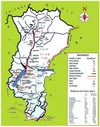|
Battlemap of Swat operations; blue arrow arrows are the Pakistani Army’s advance to date. Click map to view. |
As President Pervez Musharraf lifts the state of emergency, the Taliban in the tribal areas and the Northwest Frontier Province have united under a single banner, and a single leader. On Friday, a shura, or council, of 40 senior Taliban leaders established the Tehrik-i-Taliban Pakistan — the Movement of the Taliban in Pakistan — and appointed powerful South Waziristan Taliban commander Baitullah Mehsud its leader.
The shura was made up of Taliban representatives from the seven tribal agencies of North and South Waziristan, Khyber, Orakazi, Bajaur, Mohmand, and Kurram, as well as the settled districts of Swat, Bannu, Tank, Lakki Marwat, Dera Ismail Khan, Kohistan, Buner, and the Malakand division.
The Tehrik-i-Taliban Pakistan demanded the Pakistani military halt operations in Taliban territory and release of their members. The Taliban also stated it would continue the fight against Coalition forces in Afghanistan.
“The meeting participants have demanded an immediate end of the military operation being carried out in Swat, and given a 10-day ultimatum to the government to pullout troops from the area,” the Nation reported. The Tehrik-i-Taliban Pakistan also demanded “the closure of the military checkposts in North and South Waziristan and release of all Taliban activists including former Lal Masjid Khateeb Maulana Abul Aziz.”
“Our main aim is to target the US allies in Afghanistan but the government of Pakistan’s ill-strategy has made us to launch a defensive Jihad in Pakistan,” spokesman Maulvi Omar stated. “The government of Pakistan would be paid in the same coin now,” Mehsud said.
The consolidation of the disparate “local Taliban” movement is a logical step in the Taliban’s insurgency campaign in northwestern Pakistan. The Pakistani Taliban, while allied with al Qaeda and the Afghan Taliban, has operated as local groups. The creation of a unified Taliban movement in Pakistan will allow them to better coordinate both military and political operations inside Pakistan, as well as with the Afghan Taliban and al Qaeda.
The meteoric rise of Mehsud stems from his ability to organize and command large numbers of fighters, fend off the Pakistani military in South Waziristan, take the fight to neighboring agencies and districts, and organize a nationwide suicide bombing campaign. The government cut a deal with Mehsud in 2006 to end the fighting in South Waziristan. Last year it was estimated Mehsud commanded an army of 30,000 fighters. He has been directly implicated in a series of suicide attacks on military and government officials throughout the course of 2007.
Mehsud leaps over some able and influential Taliban leaders in North and South Waziristan, including Sadiq Noor, Mullah Nazir, and Noor Islam. It is unclear if Faqir Mohammed of Bajaur and the outlawed Tehrik-e-Nifaz-e-Shariat-e-Mohammadi (TNSM – the Movement for the Implementation of Mohammad’s Sharia Law) were represented at the meeting, but it is likely. A representative of Maulana Fazlullah’s Swat branch of the TNSM was in attendance. Abu Kasha, a key link between al Qaeda’s Shura Majlis and the Taliban, likely holds a senior position in the Tehrik-i-Taliban Pakistan.









2 Comments
Great! Sounds like they’re grouping together and designating who’s a target. It also sounds like we’re heading toward that point where the people of Pakistan will have to decide which side they’re on, which will also be good.
We know much of the key to winning the war in Afghanistan lies in Pakistan. I’m wondering, however, if the reverse isn’t also true. AQ has garnered loyalty in the tribal areas of Pakistan, despite their brutality, and this has to be based on the resources they bring into the area. So where, in an isolated tribal area do they get this money and how do they sneak it in with today’s global focus on terrorist money laundering?
Most of what AQ earns in the region probably comes from what they cut out of the world trade in opium/heroin that they supply out of Afghanistan. Between what the pay the farmer and what they charge the distributors in europe, there’s a whole lot of profit. It doesn’t seem like they have enough established encampments in Afghanistan to absorb that influx of cash. Most of their permanent outposts are in Pakistan.
It would make sense that the majority of that cash might flow to Pakistan and given the isolation of the tribal areas, it might be a little hard to bring cash in undetected by other means.
I’m wondering if killing the opium trade in Afghanistan will cripple AQ in Pakistan. Perhaps Afghanistan won’t turn around until the people there get sick enough of AQ to give up the poppy trade.
It’s just a theory, but when you think about it, it doesn’t seem like there are enough stable, permanent safe-havens in Afghanistan to absorb or protect the kind of cash a worldwide heroin supplier would produce. If Afghan opium is the lifeblood of Pakistan’s AQ/taliban they’ve got an Achilles heel on the side of the border that we control. Historically, crops have always been pretty vulnerable to the dogs of war.
Wretchard said…
Where do they get the money?
The short answer is Middle Eastern sympathizers, Islamic charities, drugs and extortion. Maybe even a little Islamic banking on the side.